A visual representation of the impact of COVID-19 in McLennan County
Story by Matti Pennington
Photos by Josh McSwain

An art installation that was in downtown Waco, known as the Bridge of Souls, created a visual representation of COVID-19’s impact in McLennan County.
Six hundred colorful banners were displayed at Indian Spring Park from Oct. 15 to Nov. 20 to represent 600 of the lives lost due to COVID-19.
As of Feb. 2, the death toll in McLennan County is 811. Cultural Arts of Waco and Creative Waco hope to do another phase of the exhibition this year to honor the remaining souls that exceeded the death toll of 600, as well as a event for the families to pick up banners.
“We had schools visit and church groups visit,” Doreen Ravenscroft said. “I want everyone who visited to feel the impact that COVID had on the Waco community. I think you can only feel it walking through it.”
The idea came to mind when the president of Cultural Arts of Waco, Ravenscroft, was planning the Waco Cultural Arts Fest.
The annual event is unique because it is six festivals all wrapped into one. The festival includes art, music, dance, science, word and film.
“The construction fencing around the suspension bridge was not very conducive to an arts festival,” Ravenscroft said. “We knew we needed to put art up, so when Fiona Bond with Creative Waco reached out about wanting to do an art project to honor those lost because of COVID-19, the idea fell into place.”
After negotiating with the city, it was brought to the even organizers’ attention that Waco did not own the fencing; it belonged to the construction company, Sparks Engineering Inc. (Engineer of Record).
“It was better to do a free-standing exhibition at the far end of Indian Spring Park,” Ravenscroft said.
In July, the planning committee met and purchased the banners.
“When we ordered 600 banners, there was a death total of around 440 people, and we never expected to use all of them,” Ravenscroft said.
The name, Bridge of Souls, was decided by Bond and Ravenscroft.
The word souls represents all the souls lost in Waco,” Ravenscroft said. “These are people we did not know but were still the fabric of our community of McLennan County and of course Waco.”
Cultural Arts Fest hired Carolina Huerta as the project manager.
“Without Carolina and an amazing number of volunteers, we could not have gotten this project done, physically, in less than two months,” Ravenscroft said.
Every banner includes a silhouette representing the person who died and was placed in order of death at the exhibition.
“There were schools and artists that did the backgrounds,” Huerta said. “We believe that the arts are a powerful means to invite people together, and this was a way to acknowledge the lives that were lost and turn the data into a visual representation.”

Waco Cultural Arts Fest and Creative Waco put together their list of artists in the area and sent out a call for volunteers. Once the artists were on board, they were asked to paint a background for their assigned person based on their age and gender.
“At that time we had chosen eight different colors that each represented a different age group,” Ravenscroft said. “This was before we had to add an age group for the young babies that were lost before they were even born. They were lost in vitro.”
Ravenscroft had a strong opinion about wanting the people to be in bright colors on the banners, not dull ones.
“These people and the souls that we had lost were vibrant people that gave color to their families and to their friends, so we wanted everyone to see them in color and not as a sad gray color,” Ravenscroft said.
Families also received an email asking if they would like to paint the background for their loved ones who were lost.
“Between 20 and 30 of the banners were actually painted by the family,” Ravenscroft said. “The families also were able to decide if they wanted the name of the person to be placed on the banner or not.”
The project ended up being a place where loved ones and family members had the chance to celebrate the lives of those they lost.
“In the beginning stages of COVID, people were not allowed to have funerals because you did not want to be in crowds,” Huerta said. “This exhibition gave them a place where they could grieve.”

